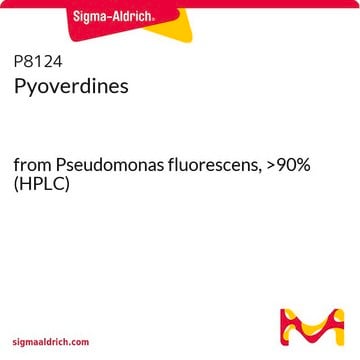모든 사진(1)
About This Item
실험식(Hill 표기법):
C16H21NO2
CAS Number:
Molecular Weight:
259.34
MDL number:
UNSPSC 코드:
12352005
PubChem Substance ID:
NACRES:
NA.25
가격 및 재고 정보를 현재 이용할 수 없음
추천 제품
분석
≥96.0% (HPLC)
양식
powder
저장 온도
−20°C
SMILES string
CCCCCCCC1=C(O)C(=O)c2ccccc2N1
InChI
1S/C16H21NO2/c1-2-3-4-5-6-11-14-16(19)15(18)12-9-7-8-10-13(12)17-14/h7-10,19H,2-6,11H2,1H3,(H,17,18)
InChI key
CEIUIHOQDSVZJQ-UHFFFAOYSA-N
일반 설명
2-heptyl-3-hydroxy-4-quinolone can function as an intercellular signal[1].
애플리케이션
Quorum sensing is a signaling system used by bacteria to coordinate activity based upon their population density. The system involves the exchange of signaling molecules among bacteria via cell receptors. Heptyl-3-hydroxy-4(1H)-quinolone (PQS) is a quorum sensing-regulated virulence factor used to induce and study the regulation of virulence genes such as those involved in iron scavenging.
포장
Bottomless glass bottle. Contents are inside inserted fused cone.
유해 및 위험 성명서
Hazard Classifications
Aquatic Chronic 4
Storage Class Code
11 - Combustible Solids
WGK
WGK 3
Flash Point (°F)
Not applicable
Flash Point (°C)
Not applicable
이미 열람한 고객
Doreen S W Hooi et al.
Infection and immunity, 72(11), 6463-6470 (2004-10-27)
Pseudomonas aeruginosa releases a spectrum of well-regulated virulence factors, controlled by intercellular communication (quorum sensing) and mediated through the production of small diffusible quorum-sensing signal molecules (QSSM). We hypothesize that QSSM may in fact serve a dual purpose, also allowing
Jintae Lee et al.
Microbial biotechnology, 2(1), 75-90 (2009-01-01)
Indole is an extracellular biofilm signal for Escherichia coli, and many bacterial oxygenases readily convert indole to various oxidized compounds including 7-hydroxyindole (7HI). Here we investigate the impact of indole and 7HI on Pseudomonas aeruginosa PAO1 virulence and quorum sensing
E C Pesci et al.
Proceedings of the National Academy of Sciences of the United States of America, 96(20), 11229-11234 (1999-09-29)
Numerous species of bacteria use an elegant regulatory mechanism known as quorum sensing to control the expression of specific genes in a cell-density dependent manner. In Gram-negative bacteria, quorum sensing systems function through a cell-to-cell signal molecule (autoinducer) that consists
Stephen P Diggle et al.
Chemistry & biology, 14(1), 87-96 (2007-01-27)
Pseudomonas aeruginosa produces 2-heptyl-3-hydroxy-4(1H)-quinolone (PQS), a quorum-sensing (QS) signal that regulates numerous virulence genes including those involved in iron scavenging. Biophysical analysis revealed that 2-alkyl-3-hydroxy-4-quinolones form complexes with iron(III) at physiological pH. The overall stability constant of 2-methyl-3-hydroxy-4-quinolone iron(III) complex
Jin-Hyung Lee et al.
Environmental microbiology, 13(1), 62-73 (2010-07-24)
Intercellular signal indole and its derivative hydroxyindoles inhibit Escherichia coli biofilm and diminish Pseudomonas aeruginosa virulence. However, indole and bacterial indole derivatives are unstable in the microbial community because they are quickly degraded by diverse bacterial oxygenases. Hence, this work
활성 필터
자사의 과학자팀은 생명 과학, 재료 과학, 화학 합성, 크로마토그래피, 분석 및 기타 많은 영역을 포함한 모든 과학 분야에 경험이 있습니다..
고객지원팀으로 연락바랍니다.












